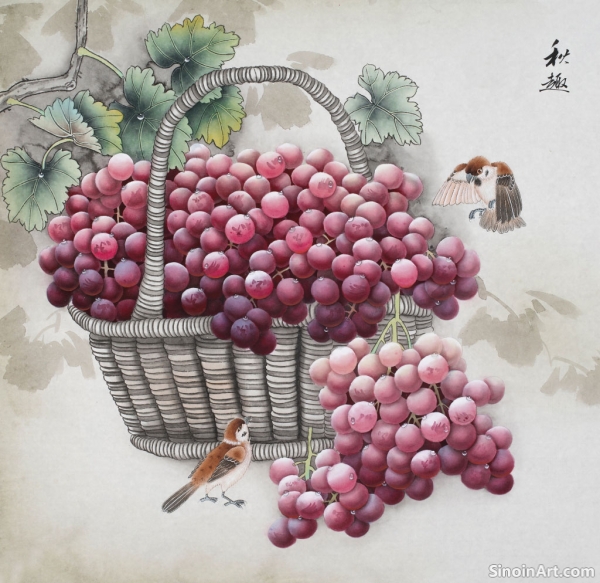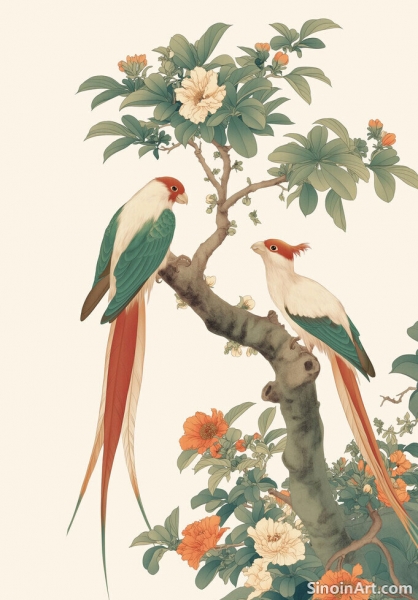Gongbi and the Court: Patronage and Artistic Standards in Imperial China
|
The history of Gongbi painting is intrinsically linked to the imperial courts of China, where it flourished under the patronage of emperors and the elite classes. The demand for highly detailed and realistic depictions of the natural world and court life led to the development of the meticulous techniques and refined aesthetic characteristic of the Gongbi tradition. This patronage significantly shaped the evolution and preservation of this distinctive style.  The imperial court established high standards for artistic execution and subject matter in Gongbi painting. Court artists were often tasked with creating detailed portraits, depictions of ceremonial events, and renderings of auspicious plants and animals that were believed to bring good fortune and prosperity to the emperor and his court. The resulting artworks often served not only as decorative pieces but also as powerful symbols of imperial power and cultural sophistication.  The materials used in Gongbi painting were often of the highest quality, including fine silk or paper, high-grade inks, and natural pigments derived from minerals and plants. Court artists were often skilled in the preparation of these materials, ensuring the longevity and vibrancy of their artworks. The use of such materials is both reflective of the social context and a testament to the value placed on artistic production.  The court patronage system also fostered a culture of artistic transmission and training. Artists often worked within established workshops, where skills were passed down through generations. This hierarchical system allowed for the preservation of techniques and the maintenance of high standards, ensuring the continuity of the Gongbi tradition. The detailed and refined process was often developed and passed down through these workshops. The legacy of court patronage on Gongbi painting is undeniable, shaping its aesthetic principles, technical standards, and symbolic content. The meticulous detail, refined elegance, and symbolic richness of Gongbi artworks are all partly a result of the demanding expectations of the imperial court. While the style continues to evolve, it remains deeply rooted in its historical association with courtly life and its desire to capture beauty with unmatched precision. |
Tag : Court Patronage Gongbi, Imperial Chinese Painting, Gongbi Art Standards, Gongbi Painting Patronage, Traditional Court Art
Related information
- Gongbi Painting and Its Cultural Significance in China
- Collecting Gongbi: Insights and Considerations for Art Enthusiasts
- The Symbolic Language of Gongbi: Exploring Motifs and Meanings
- Learning Gongbi: Steps for Aspiring Artists
- Gongbi Painting as a Form of Cultural Preservation
This article explores the cultural significance of Gongbi painting in China, highlighting its historical importance, its role in reflecting cultural values, its connection to nature, its emphasis on discipline, and its continued relevance in modern Chinese society.
This article provides insights for art enthusiasts interested in collecting Gongbi paintings, focusing on the importance of brushwork quality, authenticity, subject matter, composition, and proper care for these delicate artworks.
This article explores the rich symbolism embedded in Gongbi paintings, focusing on the meanings of flowers, animals, landscapes, and colors, and explaining how these symbols enhance the narrative and cultural significance of the artwork.
This article provides a guide for aspiring Gongbi artists, outlining the steps involved in learning the art form, including mastering brushwork, outlining, color application, understanding traditional motifs, and the importance of patience.
This article explores the role of Gongbi painting as a form of cultural preservation, highlighting its function in documenting history, preserving traditional skills, and communicating cultural values, and ensuring that heritage is passed down for future generations.